Booking
Booking
When you open a Booking it will default to the newest inserted. If you need find another Booking simply insert the Booking No. and press tab.
You can also press the Query-button and a new screen opens for you to insert Query criteria.
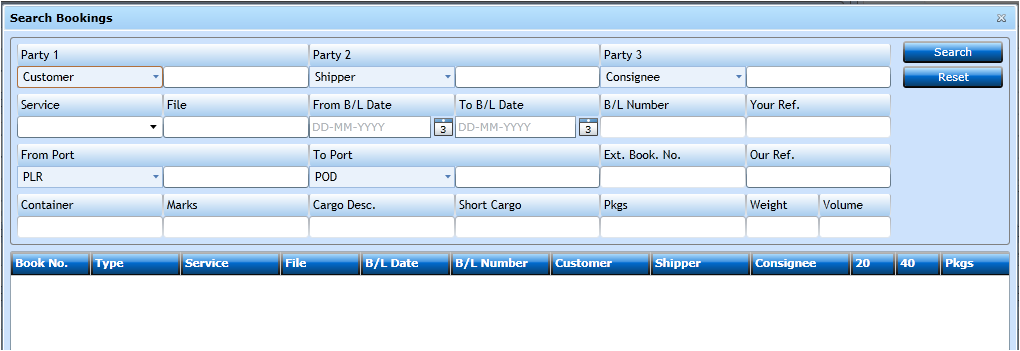
Insert the criteria and press Search or [Ctrl+Shift+S].
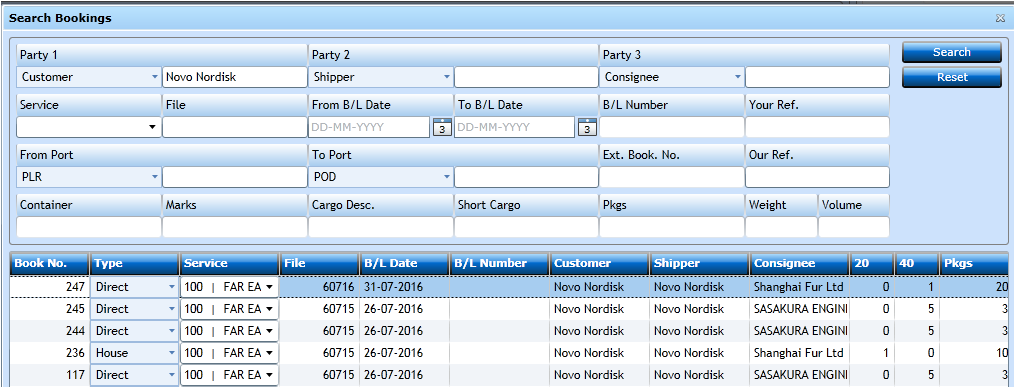
From the list you can mark the Booking you need and open by double-clicking or press OK.
If you want to create a new Booking - press New.
If you want to copy an existing Booking - press Copy Booking.
Modify the needed information and press Save [F8].
If you want to create a template - press Save as Template.
When you have a Booking which will reoccur frequently, you can save it as a template for future use.
The template is a normal Booking, but with a Booking Status (Template) which will be excluded from statistics.
Save a relevant Booking using Save as Template.
If you want to create a new Booking using a template - press Booking Templates.
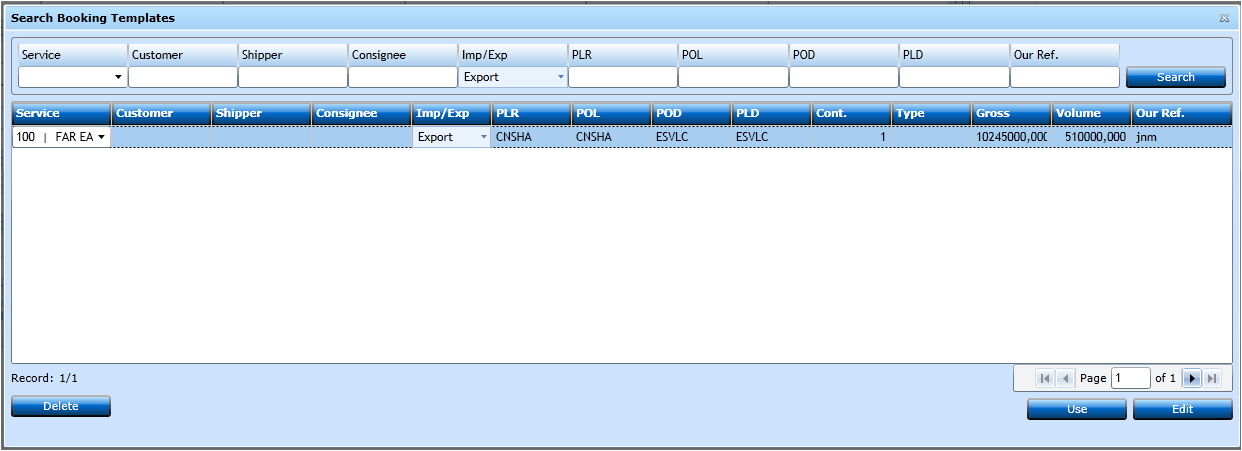
A template in the list can now be converted into a new Booking by clicking the Use-button or you can click the Edit-button to adjust the template.
You are also able to delete a template.
Remember to click on the Save-button [F8] when saving an edited template – not the Save as Template, which will create a new template.
If your set-up uses skinning on required fields, these skin-settings will be skipped in the template and only applied in for the real Booking.
The Booking Type indicator to show as template, when editing a Booking Template.

A field description will follow below.
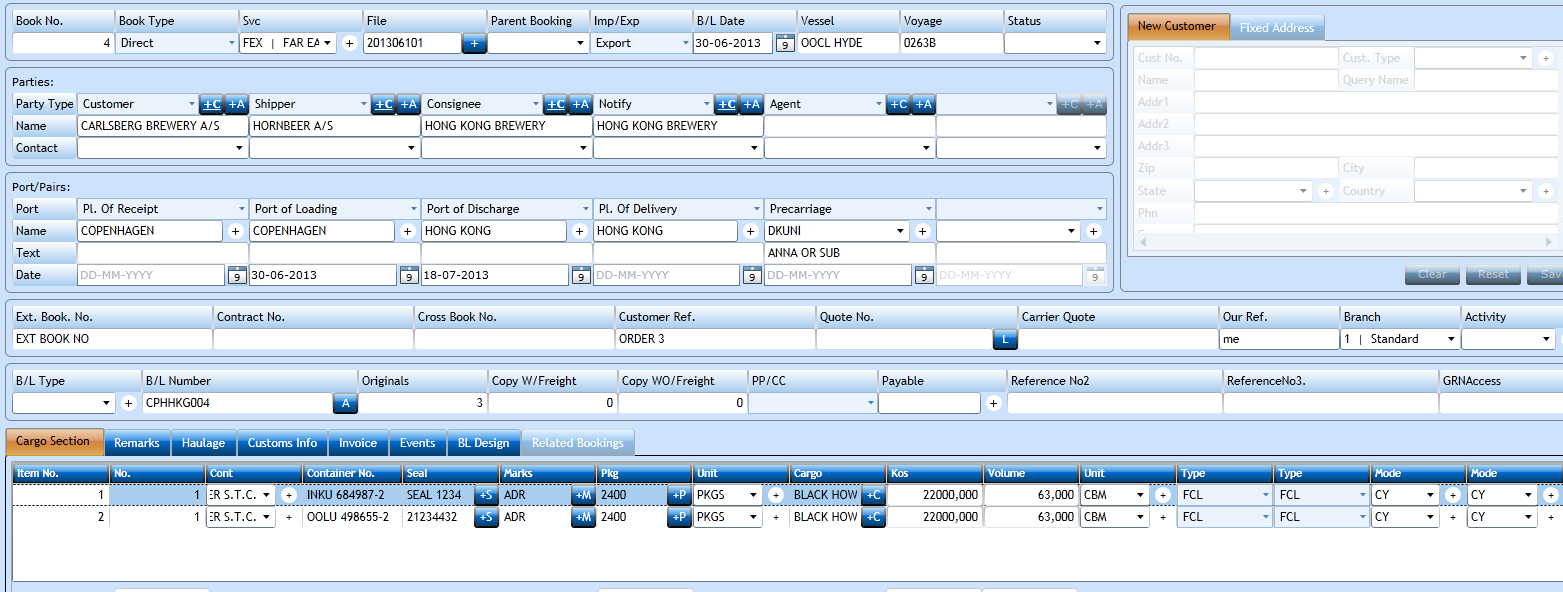
|
This is a unique reference for this Booking, and will be assigned by the system. You can search an existing Booking very easily by inserting the Booking No. and then tab through. |
|
|
From the drop-down list you can select the Type of Booking you create:
|
|
|
The Service will take the default from the Profile Setting, but you can select another using the drop-down list. Or you can type in the new Service Code using the "+". |
|
|
If you wish to add the Booking to an existing File start entering the File No. and a list of existing files will appear. |

If you wish to create a new File press "+" and a new screen will open where you can insert Carrier, Vessel and Opening Date.

Auto-Assign means the system will generate the next available File No. The rules for the File No. is defined in the Service Register.
|
The Position No. will indicate the number the Booking has on the File. Leave it empty and the system will assign next available. |
|
|
Indicates if the Booking is an Import, Export or Transit shipment. The default is picked from the Service Register, but you can amend if needed. |
|
|
Will default to Today's Date when Booking is created but can be manually amended. |
|
|
Will be inserted from the File if you linked to an existing one, or from the Create File screen above if you created the File in the Booking. |
|
|
Will be inserted from the File if you linked to an existing one. You can also amend/insert manually. |
|
|
You can set the system up to inform a Booking Status depending on the steps you design the Booking to move in. Setup is made under the Event system. |
In the Parties block you insert the Customer, Consignee and Notify details.

|
These labels are set by default, but if you need different Party Type you can choose these from the drop-down list. |
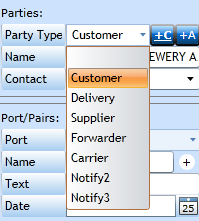
|
In the Name field you insert the Name matching the label above. If the name exists in the Customer File you simply start typing the Name or Customer No. and a list of names matching will appear. 'Mark the correct one and tab through. |

|
If you have created contact persons under the Customer in the Customer File you can select it from the drop-down list. |
Correct an address
Once you have inserted an address from the Customer File you can adjust some details if needed. Mark the Customer with the cursor and press the  .
.
This will activate the screen in the right side and you can add and/or amend details.
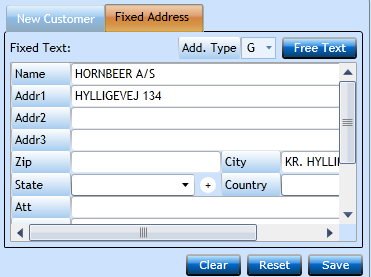
|
Add.Type |
Is set to default General Name and Address from the Customer File, but you can change to Local or Delivery. |
|
If you press Free Text then the screen will change to simple lines giving additional space for text. When ready Press Save [F8]. |
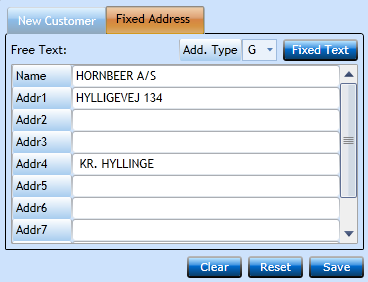
|
Clear |
Will remove existing text. |
|
Reset |
Will roll back to the text which was before you started editing. |
Create a new customer
If the Customer is not existing you can create it by pressing the 
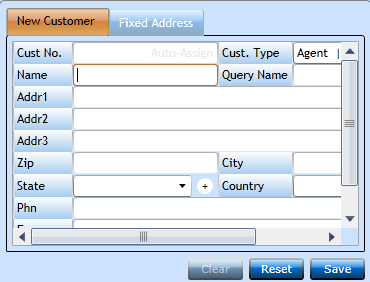
Now you can insert Name and Address. Press the Save-button [F8] and the system will ask if you wish to create Debtor or Address.
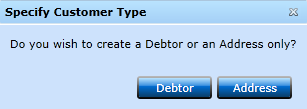
Choose Debtor if you need to create an Invoice to the Customer. Otherwise choose Address.
Now we move on to the Port/Pairs block where you can insert ports and dates.

|
The system set the label defaults as shown above, but you can modify if you wish. |
|
|
Name |
If you start typing the Name or Port Code the system will display a list of matching ports. Mark the correct one and tab through. |
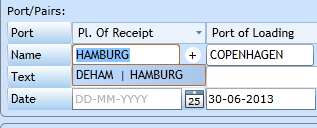
|
If you need to adjust the Name for the B/L you can insert a text here which will replace the Name in the documents printed. |
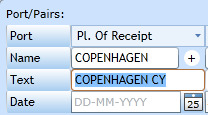
|
Insert the relevant Date for each port. If you have created a Schedule in the File the system will insert the Date from there. |
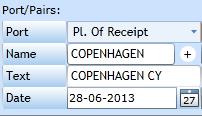
In the next block there are space for multiple Reference No.
|
Insert the carriers Booking Reference in this field. |
|
|
Here you can insert under which Contract No. the shipment is moving. |
|
|
If you book cargo via another agent or v.v., this number is the link between you. |
|
|
Here you insert your Customers Reference. |
|
|
If there is a valid Quote in the Rates Section the system will automatically suggest this when you press Link. |
|
|
Will be returned if in the linked Quote - or you can insert manually. |
|
|
Will default to the user creating the Booking. |
|
|
Will default to the Branch of the user creating the Booking. |
|
|
Will default to the Activity linked to the user creating the Booking. |

|
B/L Type can be used to decide which B/L No. Counter shall be used. Select a value from the drop-down list from the Code File B/L Type. |
|
|
You can insert a B/L No. manually or press the |
|
|
Default number of originals will be inserted from the Service Register, but can be amended manually. If this is a Sea Waybill then insert 0. |
|
|
Default number of copies with freight details will be inserted from the Service Register, but can be amended manually. |
|
|
Default number of copies without freight details will be inserted from the Service Register, but can be amended manually. |
|
|
Select the value for the Freight Payable Code. Prepaid, Collect or Elsewhere. |
|
|
After selecting the Payable Code the system will insert default value for the place where the freight is payable. This can be amended manually. |
|
|
Additional Reference field for individual use. |
|
|
Additional Reference field for individual use. |
|
|
Additional Reference field for individual use. |
![]()
Cargo Section tab-sheet
In the Cargo Section we have made it possible to insert the most frequently used information directly in the Cargo Line, while additional information can be inserted pressing the buttons below the Cargo Lines.
when pressing one of these buttons the details will be attached to the Cargo Line highlighted when pressing the button.

Press the Add-button [F2] and a new line will open for input.
|
System will assign the next available number for the Cargo Line. Apart from showing the number of Cargo Lines this number can be used in the Haulage Tab-Sheet. |
|
|
If containers then indicate the number of containers in the Booking. Eventually you will end up having at least 1 Cargo Line per Container, but you can start the Booking just inserting 2 x 20' in 1 line, and 2 x 40' in the next line. |
|
|
If containers select the correct Container Type. These are inserted in the table Container Information. |
|
|
Container No. |
Insert the Container No. The number will be checked against the check digit. If incorrect you will get a notice. |

|
Insert the Seal Number. If there are multiple seal numbers press the Press OK to return to the Cargo Line. |
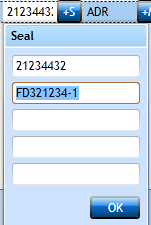
|
Marks |
Insert the Marks and Numbers for the cargo. If there are multiple Marks and Nos lines press the |
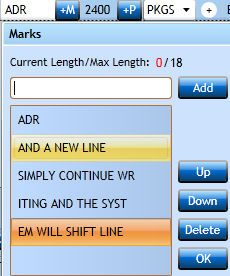
|
Insert the Number of Packages in the Cargo Line. If you need to register Inner Packing for Hazardous Cargo then press |
|
|
Insert the Type of Packing from the drop-down list displaying values from the table Package Types. If you need to control these codes are always used you can set a switch in the Service Register. You need to find the check for Manually Assign Package Type and set this to No. |
|
|
Insert the Cargo Description. If 1 line is not enough press the |
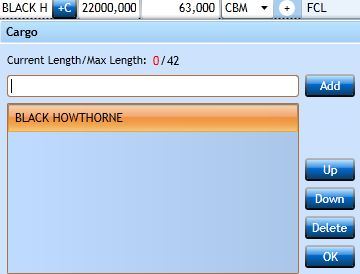
|
Insert the Gross Weight of the cargo in Kilos. Can contain up to 3 digits. |
|
|
Insert the measurement in the measure indicated in the Unit field. |
|
|
Insert the Volume Unit. You can select via the drop-down list displaying valid fields from the table Volume Units. |
|
|
Select the valid Service Type from the drop-down list. |
|
|
Select the valid Service Mode from the drop-down list displaying valid values from the table Service Modes. |
If you need to insert additional information then press the button corresponding to the information you need to add.
IMCO-button
When pressing the IMCO-button the screen will open with the details of the Cargo Position highlighted.

You can shift Cargo Position pressing the  arrows.
arrows.
The first line will display the details of the Cargo Position you are going to add IMCO details for.
IMCO Page, IMCO Class, EMS and MFAG cannot be amended in this screen. Here you have to amend in the IMCO Register directly. Press the  plus next to the UNNO and the
plus next to the UNNO and the
IMCO Register will open for amending. After you have saved the change reselect the UNNO in the Booking and the field will be updated.
Other fields can be amended directly in the Booking to match the requirements. Press Save [F8] when ready.
Press  to get back to the Cargo Position.
to get back to the Cargo Position.
Reefer/Spec.units-button
When pressing the Reefer/Spec.units-button the screen will open with the details of the Cargo Position highlighted.

You can shift Cargo Position pressing the  arrows.
arrows.
In the Spec. block you insert dimension of Out Of Gauge Cargo or if the cargo has been stuffed in special Container with over dimensions. Normally the dimensions are inserted in meters.
|
Insert the Length. |
|
|
Insert the Width. |
|
|
Insert the Height. |
|
|
Insert the Weight of the Container. This can be automatically inserted if the field Tare is updated in the table Container Information. |
In the Reefer block you insert Reefer Temperature Settings required for this shipment.

|
Insert the lowest temperature allowed in the reefer during transportation. |
|
|
Insert the highest temperature allowed in the reefer during transportation. |
|
|
Select the corresponding temperature unit from the drop-down list. |
|
|
Indicate the ventilation function selecting a value from the drop-down list. |
In the Handling Codes section you can add codes for special handling - used when exchanging EDI.
Handling 1-4
Select a valid Code from the table Handling Codes via the drop-down list.
Press Save [F8] when ready.
Press  to get back to the Cargo Position.
to get back to the Cargo Position.
MRN/Customs-button
In this section you can add Customs Information for each Cargo Position. Information on shipment level will be added in the Customs Info tab-sheet.

When pressing the button the screen will open with the details of the Cargo Position highlighted. You can shift Cargo Position pressing the  arrows.
arrows.
|
Insert a valid Cargo Commodity Code from the drop-down list displaying values from the Commodity Register. |
|
|
Is automatically filled in when the CCC No. is selected. The text displayed is Text 1 from the Commodity Register. |
|
|
Is automatically filled in when the CCC No. is selected. The number displayed is Commodity Code from the Commodity Register. |
|
|
Select the Country of Origin from the drop-down list displaying values from the Code File Countries. |
|
|
Insert the Procedure Code. |
|
|
Insert the value for Supplementary Units if applicable. |
|
|
Insert the value for the Statistical Value of the Cargo. |
|
|
Select the correct T-Status for the shipment. The default is set in the Service Register. |
|
|
Select the Preference Code from the drop-down list displaying valid values from the Code File Preference Codes. |
|
|
This field is reserved for the Customs Reference returned form the customs system. |
|
|
If the Cargo is sensitive then insert the number of sensitive packages. |
|
|
If the Cargo is sensitive then insert the Type of Packing. |
In the next block you can insert additional information required for the customs procedure. Depending on the procedure you can choose between different information.
Press the Add-button [F2] and a new line will open for input.

|
Select the Type of Information you wish to add from the drop-down list. |
|
|
If a Document Code is chosen you need to select a Document Type in the Code field. |
|
|
Insert the Document No. - or if MRN the MRN No. |
|
|
If the MRN is complete check the box and leave the remaining fields empty. |
|
|
Insert the Cargo Item No. for incomplete items in the MRN. |
|
|
At the last cargo item which completes the MRN check the box. |
|
|
If the MRN is not complete insert the number of units included in this line. |
|
|
When the last units in the MRN are sent check the box to indicate the MRN is complete. |
|
|
Insert the remaining Weight of the incomplete MRN. |
|
|
Insert the total Gross Weight. |
Press the Save-button [F8] or Add [F2] if you wish to insert additional customs information.
Press  to get back to the Cargo Position.
to get back to the Cargo Position.
Freight Charges
In this section you can add charges which can be printed in the B/L, Manifest or attached to a Settlement.
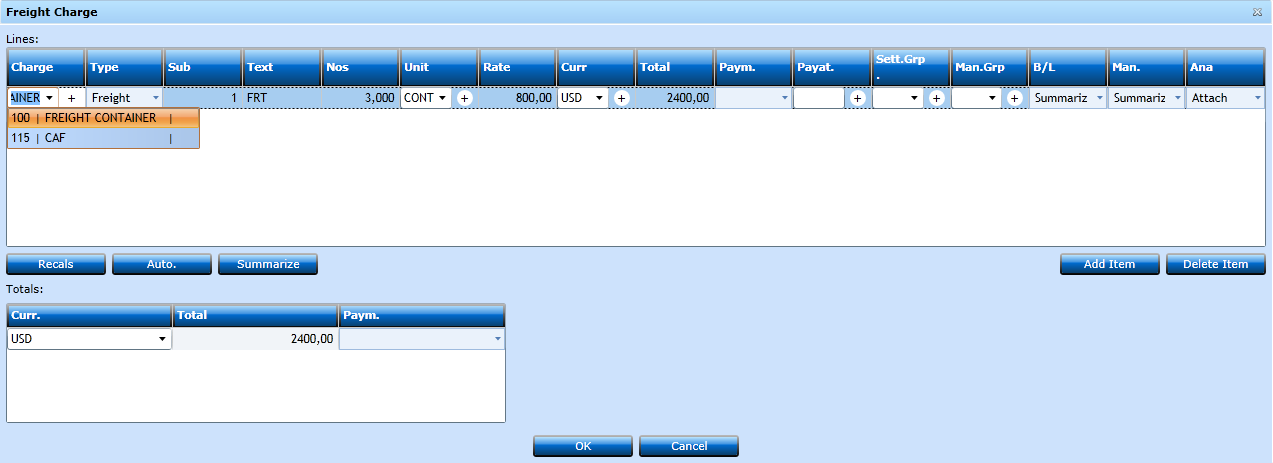
Press the Add-button [F2] and a new line will open for input.
|
Select a valid Charge from the drop-down list displaying valid values from the Charges table. |
|
|
Will default from the field Inv. Code in the Charge. Can be amended manually. |
|
|
Will default from the field Subtotal in the Charge. Can be amended manually. |
|
|
Will default from the field B/L Text in the Charge. Can be amended manually. |
|
|
The system will calculate the number of containers from the Cargo Positions. |
|
|
Will default from the field Price in the Charge. Can be amended. |
|
|
Will default from the field Curr in the Charge. Can be amended. |
|
|
The system multiplying Nos Rate. |
|
|
Will default from the field Pay. Code in the Charge. Can be amended. |
|
|
Indicate where the freight is payable be selecting a valid Code. |
|
|
Will default from the field Settl. Grp in the Charge. Can be amended. |
|
|
Will default from the field Man. Grp. in the Charge. Can be amended. |
|
|
Will default from the field Prt. B/L in the Charge. Can be amended. |
|
|
Will default from the field Prt. Mnf in the Charge. Can be amended. |
|
|
Will default from the field Prt. Analysis in the Charge. Can be amended as well. |
Add as many charges you need pressing the Add Item-button [F2].
Below the charges you see 3 buttons.

|
Recalc |
Will be used if you change some of the rates and other calculations are depending on these rates. Pressing Recalc will then do a complete recalculation of all lines so you do not have to reinsert these. |
|
Auto. |
If you have linked a Quote with a Costs Section then pressing Auto will insert these charges from the Quote Cost Part. |
|
Summarize. |
Has no function at this moment. |
Remarks tab-sheet
In this sheet you can insert text and direct it to a specific report/document.

Press the Add-button [F2] and a new line will open for input.
|
Type |
From the drop-down list you can decide in which document the remark(s) shall be printed. |
|
At |
In this drop-down list you can select a set of remarks from the Remarks table. |
|
Code |
If you select a full set of remarks from the Remarks table this will have a default. But you can amend to another value in the drop-down list displaying codes from the Remark Code table. |
|
Text |
Insert the text you want to print in the document. If you have linked from the Remarks table it will be inserted automatically. |
Haulage tab-sheet
In this section you can add information for ordering local pick up or delivery of the shipment. Depending on the Service Type in the Cargo Position the system will default to FCL or LCL,
having slightly different input fields.

When the haulage is for FCL the screen will have following fields.
|
Choose if FCL or LCL. The system will take the default form the Cargo Section. |
|
|
Select a valid Carrier from the drop-down list displaying values from the Code File Carrier. If missing you can create directly in the Code File Carriers pressing the "+". |
|
|
This will be assigned by the system for the next available line in this Booking. You can issue multiple haulages from this screen. |
|
|
If you have created a Sequence in the table Transport Document No., the system will select next available when printing the document. You can add manually as well. |
|
|
Possibility to the Haulier Quote No. if received. |
|
|
Here you can indicate who shall pay for the haulage. Start typing the Name and the system will display a drop-down list with matching names. |
|
|
Select the Currency in which the transport will be invoiced. You can select a valid value from the drop-down list displaying values from the Currencies table. |
|
|
Possibility to insert the rate agreed for the haulage. |
|
|
If you exchange EDI with the Haulier this field is reserved for the Booking No. returned from the Haulier. |
|
|
If you exchange EDI with the Haulier this field is reserved for the confirmed Haulage Date. |
|
|
If you exchange EDI with the Haulier this field is reserved for the confirmed Haulage Time. |
|
|
System will update the status as the haulage booking proceeds through the system. |
In the next line the loading information is inserted - where the Container shall be loaded and when.

|
In this drop-down list you can select where to load if the address is already inserted in the Parties block above. When selecting a party the system will insert the details. You can also leave Type empty and insert the details manually. |
||
|
When selecting Type, the Name of the Party will be inserted, but you can amend manually as well. |
||
|
If the loading address is in the Customer Register you can select a contact name from the Customer Contacts. |
||
|
When selecting Type, the Address of the Party will be inserted, but you can amend manually as well. |
||
|
Insert the Date when the Container has to arrive at the address for loading or unloading. |
||
|
Insert the Time when the Container has to arrive at the address for loading or unloading. |
||
|
Remarks |
|
In the last section you can add the details of the container and/or cargo pressing one of the two buttons or delete cargo.

 Pressing the Add Entry-button, will open a new screen displaying the various cargo positions in the Booking.
Pressing the Add Entry-button, will open a new screen displaying the various cargo positions in the Booking.

Select the one you will issue haulage for and press OK, and the system will insert the details in the haulage tab.
![]() Pressing the Add Cargo-button will simply open a new line for manual input.
Pressing the Add Cargo-button will simply open a new line for manual input.
|
Item No. |
Links to the Cargo Section Item No. When selected, the system will copy the details from this Item No. in the Cargo section, when you use Add Entry. |
|
Display the Container No. - If using Add Cargo you have to insert manually. |
|
|
Pkgs |
Display the number of packages. Can be amended manually. |
|
Unit |
Display the packages units. Can be amended manually. |
|
Kos |
Display the Gross Weight. Can be amended manually. |
|
Volume |
Display the measurement. Can be amended manually. |
|
Unit |
Display the measurement unit. Can be amended manually selecting another valid value from the drop-down list displaying units from the Code File Volume Unit. |

|
Choose if FCL or LCL. The system will take the default form the Cargo Section. |
|
|
Select a valid Carrier from the drop-down list displaying values from the Code File Carrier. If missing you can create directly pressing the "+". |
|
|
This will be assigned by the system for the next available line in this Booking. You can issue multiple haulages from this screen. |
|
|
If you have created a Sequence in the Transport Doc Nos table, the system will select next available when printing the document. You can add manually as well. |
|
|
Possibility to the Haulier Quote No. if received. |
|
|
Select the Currency in which the transport will be invoiced. You can select a valid value from the drop-down list displaying values from the Currencies table. |
|
|
Possibility to insert the rate agreed for the haulage. |
|
|
If you exchange EDI with the Haulier this field is reserved for the Booking No. returned from the Haulier. |
|
|
Trailer No. |
If you exchange EDI with the Haulier this field can be updated by them, but you can also insert manually. |
|
If you exchange EDI with the Haulier this field is reserved for the confirmed Haulage Date. |
|
|
If you exchange EDI with the Haulier this field is reserved for the confirmed Haulage Time. |
|
|
System will update the status as the haulage booking proceeds through the system. |

In the next block you have to insert Name and Address for the pick-up and delivery of the cargo.

In the first line insert details of pick-up and delivery in the second.
|
In this drop-down list you can select where to load if the address is already inserted in the Parties block above. When selecting a Party the system will insert the details. You can also leave Type empty and insert the details manually. |
|
|
When selecting the Type, the Name of the Party will be inserted, but you can amend manually as well. |
|
|
If the Loading Address is in the Customer Register you can select a contact name from the Customer Contacts. |
|
|
When selecting the Type the Address of the Party will be inserted, but you can amend manually as well. |
|
|
Insert the Date for the cargo to be picked-up and delivered. |
|
|
Insert the Time for the cargo to be picked-up and delivered. |
Next line is for additional information.

|
Here you can indicate who shall pay for the haulage. Start typing the Name and the system will display a drop-down list with matching names. |
|
|
Possibility to insert additional information. |
In the last section you can add the details of the container and/or cargo pressing one of the two buttons.
Pressing the Add Entry-button will open a new screen displaying the various cargo positions in the Booking.

Select the one you will issue haulage for and press OK, and the system will insert the details in the Haulage tab.
![]() Pressing the Add Cargo-button will simply open a new line for manual input.
Pressing the Add Cargo-button will simply open a new line for manual input.

|
Links to the Cargo Section Item No. When selected the system will copy the details from this Item No. in the Cargo section, when you use Add Entry. |
|
|
Display the Marks and Nos - If using Add Cargo you have to insert manually. |
|
|
Display the number of packages. Can be amended manually. |
|
|
Display the Package Units. Can be amended manually. |
|
|
Display the Cargo Description. Can be amended manually. |
|
|
Display the Gross Weight. Can be amended manually. |
|
|
Display the measurement. Can be amended manually. |
|
|
Display the measurement unit. Can be amended manually selecting another valid value from the drop-down list displaying units from the Code File Volume Unit. |
|
|
Insert the number of exchange pallets in this transport. |
|
|
Insert the Type of Pallets being exchanged. Select a valid unit from the drop-down list displaying valid units form the Code File Pallet Types. |
Customs/Add. tab-sheet
In this tab you can insert customs information on cargo position level and additional information. Some information will be on shipment level. This information will be inserted in the Customs tab.

|
Insert the Standardized Code for the customs document to be printed in the first part of the DECLARATION field. |
|
|
Insert the Standardized Code for the customs document to be printed in the second part of the DECLARATION field. |
|
|
Insert the Standardized Code for the customs document to be printed in the FORMS field. |
|
|
If Country has been inserted in the shipper details, this field will be automatically filled in. But you can amend or insert choosing a valid Code from the drop-down list displaying values from the Code File Countries. |
|
|
If Country has been inserted in the consignee details, this field will be automatically filled in. But you can amend or insert choosing a valid Code from the drop-down list displaying values from the Code File Countries. |
|
|
Indicate if this shipment shall be reported to Intrastat. If it shall select Yes else No. |
|
|
Indicate if the shipment shall be reported as containerized. 0 = do not report, 1 = report. |
|
|
For import cargo you can select the Arrival Terminal from the drop-down list displaying values from the Code File Arrival Terminal. |
|
|
Indicate if the Arrival Date and Time is Actual or Expected. |
|
|
Insert the Arrival Date. |
|
|
Insert the Arrival Time. |
|
|
Select the Country Code of the Invoice Currency from the drop-down list displaying values from the Code File Countries. |
|
|
Insert the Invoice Amount. |
|
|
Insert the Invoice Date. |
|
|
Insert the Invoice No. |
|
|
Choose the Invoice Currency from the drop-down list displaying values from the Currencies table. |
|
|
Insert the Invoice Value. |
|
|
Insert the previous Customs Reference if existing. |
|
|
Select the Delivery Terms from the drop-down list displaying values from the Code File Delivery Terms. |
|
|
Insert the Name of the Place where the Delivery Terms end. |
|
|
Insert additional information to the customs in the 4 fields. |
Now you need to insert information where the Container can be picked up and where it shall be returned.

First line is where to pick up the Container. If Import then it will be the Terminal and for Export the Depot. Second line where to return the Container.
|
Insert the Name of the Terminal/Depot. Start typing the Name and the system will display a list of valid valued from the Code File Container Locations. If the Code is not there you can enter directly pressing the |
|
|
Insert the Release and Return Reference. |
|
|
Select the Date when the Container is ready for pick-up and the latest Date for Return. |
|
|
Insert the Hour when the Container is ready for pick-up at latest return. |
Invoice tab-sheet
In the invoice tab you can create Multiple Invoices, Credit Notes, Settlements, Internal Invoices and Group Invoices.

If you have linked a Quote you can simply press the Auto Invoice-button and the system will insert the invoice to the Customer. Pressing the Auto Estimate will insert
the estimate(s) in the Quote cost part. If you did not link a Quote then press the Add-button [F2] and a new line will open.

|
Will display each Invoice made with a unique Order No. |
|
|
Select the Type of Document you wish to issue. Default will always be Invoice or Group Invoice if indicated in the Customer Register. If you need to insert an Estimate, the Type must be Settlement and status at the end of the line Estimate. |
|
|
If issuing a Credit Note you may wish to see the reason. If this is the case then select a valid value from the drop-down list displaying values from the Code File Reason Code. You may even be forced to insert a Code before issuing a Credit Note if the setting in the Allow credit with reason is chosen in the Company Register. These settings are controlled by the accounting department. |
|
|
Will default from the Customer in the Parties section but you can amend by overwriting. You will only be able to insert a Party having a valid Debtor Group in the Customer Register. |
|
|
Will default from the Customer Register in the Debtor Curr. You can amend this manually choosing another Currency in the drop-down list. |
|
|
If you choose Internal Invoice in Type you can issue an Invoice from this Booking to another Booking. Insert the receiving Booking No. here, or go to the next field. |
|
|
If you choose Internal Invoice in Type you can issue an Invoice from this Booking to another File. Select a valid Service from the drop-down list, and go to the next field and insert File No. |
|
|
If you choose Internal Invoice in Type you must insert the File No. here. This will be automatically inserted if you already added the Booking No. |
|
|
The Terms of Payment will default from the Customer Register in the Debtor T.o. Paym. If allowed internally you can adjust manually. |
|
|
Will be inserted automatically when the invoice is printed after the rules stipulated in the Service register. |
|
|
Svc.Date |
Legal requirement in Poland and Baltic countries for VAT reporting purpose. |
|
Job No. |
Can combine result for several Modules (Air, Sea etc.) projects via unique Job. No. |
|
Status |
Will show the status of the Invoice or Estimate |
|
The invoice number will be assigned when the invoice is printed. |
|
|
Indicates who issued the invoice. |
|
|
|
|
|
Show PDF |
If you send E-mail invoices it will be shown here after Invoice Distribution is executed by finance provided the customer set up is for E-mail Invoice |
Now press the Invoice Details-button
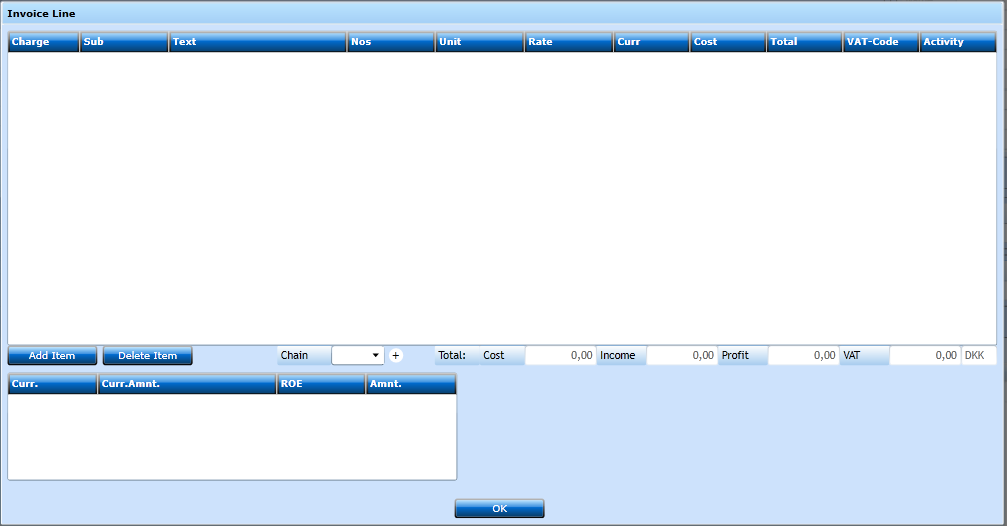
Now you can insert the Invoice Lines by pressing the Add item-button or use the Charge Chains function.

A new line opens for input.

Depending on the creation of the charges the system will now insert the default values from the selected Charge. You can amend each field manually if needed.
Please refer to the Charges Calculation Type section for explanation of the setup.
Press Add Item to insert another line if needed, or OK to return to the Invoice header.
While in the Invoice tab sheet press the Print-button and the Invoice will be printed.
Events tab-sheet
In the Events tab-sheet you can see the events or Manual Fire Events.

The events can be configured through the Event System.
|
Date |
Will display the Date of the Event. |
|
Time |
Will display the Time of the Event. |
|
User |
Will display the user id of who did the Event. |
|
Event Name |
Will display the Event Name. |
|
Text |
Will display a short description of the Event. |
|
Remark |
Here you can enter a Remark in free text. |
|
Status |
Will display the Book Event Status Code. |
|
Files |
Here you can upload a file to the specific event if needed. |
|
|
|
You can also press the button 
Here you can fire a manual event.
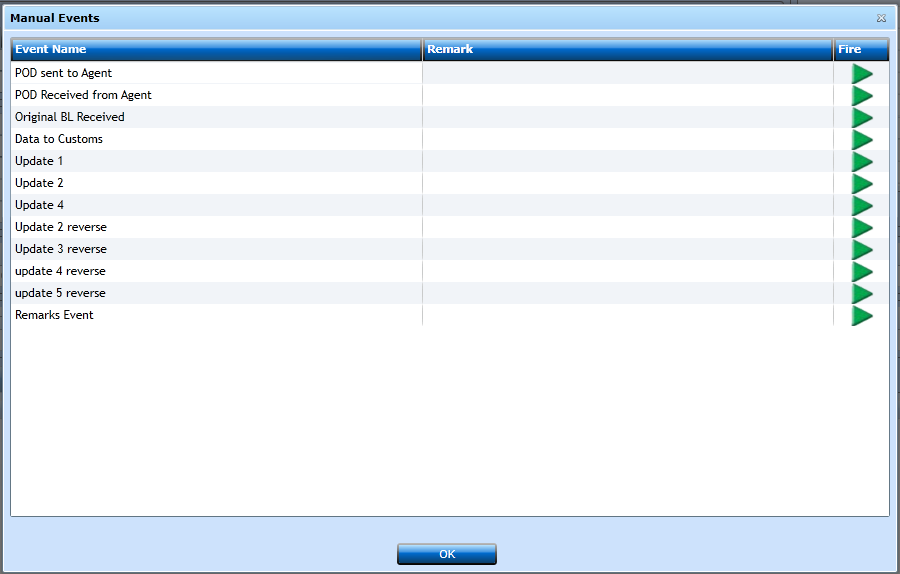
Press Fire on the event you want and you will see this message when done.

The manual Event will be visible in the Events.





